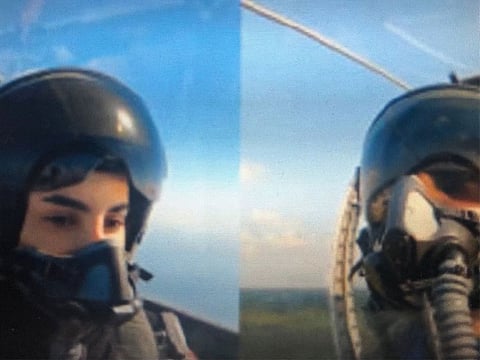Watch: UAE astronauts Nora Al Matrooshi, Mohammad Al Mulla prepare for space journey
Next task is to fly a supersonic jet, faster than the speed of sound

Dubai: The second batch of UAE astronauts, comprising Nora Al Matrooshi and Mohammad Al Mulla, is preparing for the next step of the space journey, following individual manoeuvering of T-6 aircraft as part of the NASA Astronaut Candidate Class.
Al Matrooshi, 29, the UAE’s first female astronaut who is a mechanical engineer by education; and Al Mulla, 34, a helicopter pilot at Dubai Police, are in the thick of an intensive two-year astronaut training programme (Class 23) that began in January this year at NASA’s Johnson Space Centre – a hub of human spaceflight activity for more than half a century – in Houston, Texas.
Mohammed Bin Rashid Space Centre earlier tweeted a video showing Al Matrooshi and Al Mulla flying a T-6, a single-engine turboprop aircraft used for pilot training, as part of their training at the NASA Astronaut Candidate Class.
360° revolution
The flight training covered a variety of manoeuvres, including loop and aileron roll (an aerobatic manoeuver in which an aircraft does a full 360° revolution around its roll axis). The duo flew after completing ground school and simulator flying courses.
On his official Instagram account, Al Mulla posted a short video of him flying the aircraft and captioned it: “I’m still at the beginning of the road, and this is a step forward towards the future.”
Supersonic jet
Next task for Al Matrooshi and Al Mulla is to fly a T-38 jet at supersonic speed, that is faster than the speed of sound.
According to NASA, a T-38 – which is a two-seater, twinjet supersonic jet trainer – “can fly supersonic up to Mach 1.6 and soar above 40,000 feet, about 10,000 feet higher than airliners typically cruise.”
“The plane can wrench its pilots through more than seven Gs, or seven times the force of gravity. That’s enough to make simply lifting hands a feat of strength and breathing a laboured chore. It’ll make one’s neck feel like it is balancing a cinder block. It’s also more than enough to make the average person black out,” NASA added.
The objective of the flight training to prepare the astronauts to “think fast.”
“Anyone who didn’t fly a T-38 before they got to NASA, learned to fly it once they joined the astronaut corps. Basic astronaut training includes T-38 courses, and mission specialists, who do not sit at the controls of a space shuttle, have to record four hours a month at the stick of a T-38. Commanders and pilots are required to fly the T-38 for 15 hours a month to keep up their proficiency,” NASA noted.
Preparing for spacewalk
The later stages of the NASA Astronaut Candidate Class involve, among other, operating robotic arms for capturing spaceship cargo and performing spacewalks, which have been accomplished UAE pioneer astronauts Hazzaa Al Mansoori and Sultan Al Neyadi.
On Friday, June 3, Al Neyadi tweeted photos of himself training the Partial Gravity Simulator (POGO), which is used for astronaut training and for evaluating their ability to perform tasks in simulated partial and microgravity.
Al Neyadi said: “In addition to the NBL (Neutral Buoyancy Laboratory) training we use the Partial Gravity Simulator or POGO. The system offsets the weight in a way that if l release my grip I would float away with a minimum push.”
Sign up for the Daily Briefing
Get the latest news and updates straight to your inbox


